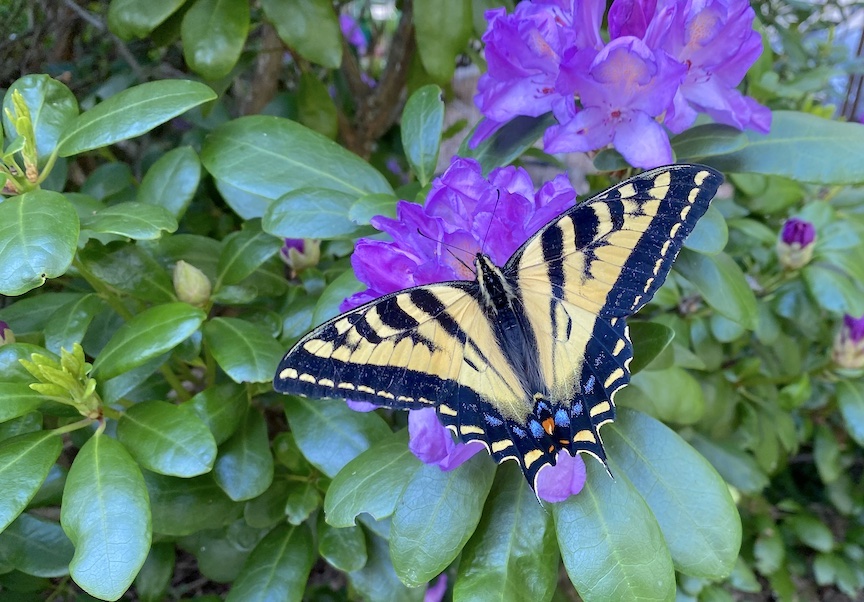by Bruce Bennett • In June, the Woodland Park Zoo in Seattle reopened the Molbak’s Butterfly Garden after a two-year pandemic-related closure. Why would a zoo dedicate precious urban space to an exhibit which is open for only four months of the year?
The 20 or so varieties butterflies that call western Washington home are choosy insects. Any gardener can have aphids, but Red Admirals, Painted Ladies and Tiger Swallowtails and all their kin insist upon certain environmental niceties, such as sunshine, shelter from wind and protection from the winter wet. The zoo also provides the space because butterflies as well as other pollinators are becoming even more endangered.
Pollinators are important to the overall health of the human ecosystem and how they help to keep us thriving and eating. You can increase your butterfly viewing opportunities by creating garden spaces which are attractive to them. To butterflies, the plants in the garden are more important than the design of the garden. They need flowers for nectar throughout the short season of their lives.
Luckily, many annuals, perennials, shrub and tree flowers are great nectar producers throughout the year. While native plants can play an important role as host plants for butterfly caterpillars, most adult butterflies have more cosmopolitan tastes and are able to get their fill on the more exotic flowers that you grow in your landscapes.
Butterflies seem to be especially attracted to gardens boasting generous patches of a given nectar flower. If you plant the robust Jupiter’s-Beard (Centranthus), don’t settle for one or two plants. A drift of three to seven plants will provide an excellent meal for your colorful visitors and, at the same time, provide you with a garden color spot surrounded by the aerobatics of butterflies, moths and hummingbirds.
I am fairly successful at having flowers blooming in the yard for 12 months a year. This planning process certainly helps to visually enhance my window views and increases the smorgasbord menus that pollinators can enjoy, some more than others (think about our resident hummingbirds). Plants such as mahonia, azaleas, grape hyacinths, lilacs and pinks can start the menu in late-winter through mid-spring.
Achilleas, asclepias, germander, perennial phlox and Jupiter’s Beard provide color and nectar in July and August. For September and October, abelia, caryopteris, purple asters, sneezeweed and coreopsis will help to fill-out the pollinator menu. The list of nectar-producing plants is long and varied and will change from one part of the state to another. Talk to volunteers at a local Master Gardener Clinic, or visit your local library and/or surf the Internet for specific information on your part of the world. To be a good gardener, you need to also be a good researcher!
Start a pollinator garden area in a location that gets at least six-hours of sunlight. Butterflies need the sun’s warmth and most plants that attract butterflies grow best in full sun. Determine how much space you have and any items, other than plants, that you’d like to include. Consider adding a large flat rock or two. Butterflies enjoy basking on them, often with their wings spread out to catch more rays. Also allow room for a pot saucer filled with mud or moist sand as a water source to encourage butterflies to linger longer. Create this manufactured puddle in low-profile a container with which to attract swallowtails and other butterflies that enjoy drinking at mud puddles. (They do so to obtain needed salts in their diet.) A sprinkling of table salt and the addition of some manure each year will increase the puddle’s appeal, for pets and kiddos if not butterflies. After their first year, these pollinator gardens can become low-maintenance areas of the landscape.
With proper planning, good plant selection and minimal maintenance, Western Washington gardeners can create a garden area that will not only attract butterflies and help to preserve these important and beautiful insects that are so vital to our ecosystem, but, also provide we homeowners with many garden-produced smiles throughout the year and I’m all for that. Happy Gardening, all!
For More Information:
- Burns, Deborah, ed. Attracting Native Pollinators, North Adams, MA: Storey Publishing, 2011.
- Fleming-Hayes, Rhonda. Pollinator Friendly Gardening: Gardening for Bees, Butterflies, and Other Pollinators, McGregor, MN: Voyager Press, 2016.
- Johnson, Lorraine & Colla, Sheila. A Northern Gardener’s Guide to Native Plants and Pollinators, Washington, DC: Island Press, 2023.
- Kruckeberg, Arthur & Chalker-Scott, Linda, Gardening With Native Plants of the Pacific Northwest, Seattle, WA: University of Washington Press, 2019.
- Lewis, Alcinda. Butterfly Gardens, Brooklyn, NY: Brooklyn Botanic Gardens, 2001.
Contributing garden columnist Bruce Bennett is a Washington State University Master Gardener, lecturer and Seattle-area garden designer. If you have questions concerning this article, have a gardening question or two to ask concerning your own landscape or want to suggest a topic for a future column, contact Bruce at gardenguy4u@gmail.com.


